Abstract
Acetylcholine (AcCho) release from purely cholinergic Torpedo synaptosomes was evoked by K+ depolarization in the presence of Ca2+. Activation of muscarinic receptors, present in the synaptosomal fraction, by the agonist oxotremorine resulted in the inhibition of AcCho liberation. This inhibition was abolished by the muscarinic antagonist atropine, which by itself has no effect. These findings suggest that the muscarinic receptor, present in the electric organ of Torpedo is presynaptic and that its physiological function is to regulate AcCho release by negative feedback. The mechanism of presynaptic muscarinic inhibition was investigated by examining the effect of muscarinic ligands on synaptosomal 45Ca2+ uptake and on the level of phosphorylation of specific synaptosomal proteins. Ca2+-dependent K+ depolarization-induced synaptosomal AcCho release was accompanied by 45Ca2+ uptake and by a marked increase in the phosphorylation of a specific synaptosomal protein (band alpha) of approximately 100,000 daltons. Activation of the muscarinic receptor by the agonist oxotremorine had no detectable effect on synaptosomal 45Ca2+ uptake but resulted in the concomitant inhibition of AcCho release and of phosphorylation of band alpha. The muscarinic antagonist atropine abolished the inhibitory effect of oxotremorine both on AcCho liberation and on phosphorylation of band alpha. These findings suggest that phosphorylation of band alpha may be involved in regulation of the presynaptic processes that underly AcCho release and that activation of the muscarinic receptor by agonists may inhibit AcCho release by blocking the phosphorylation of band alpha.
Full text
PDF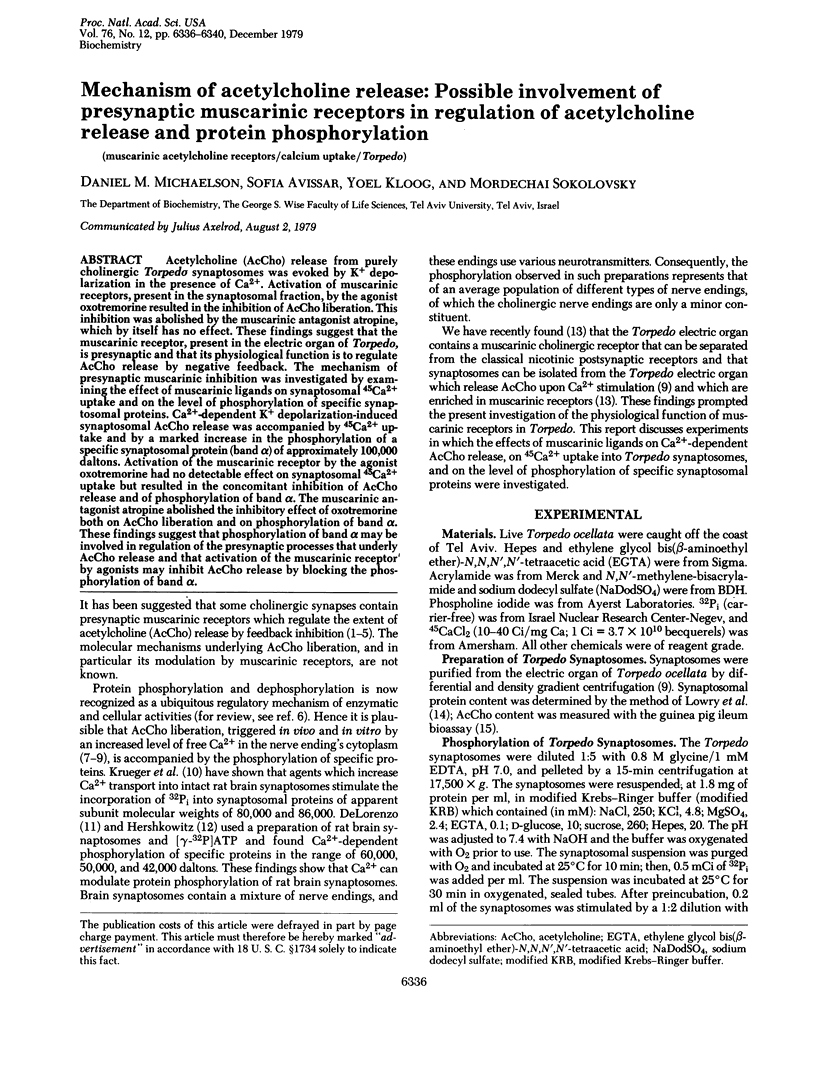
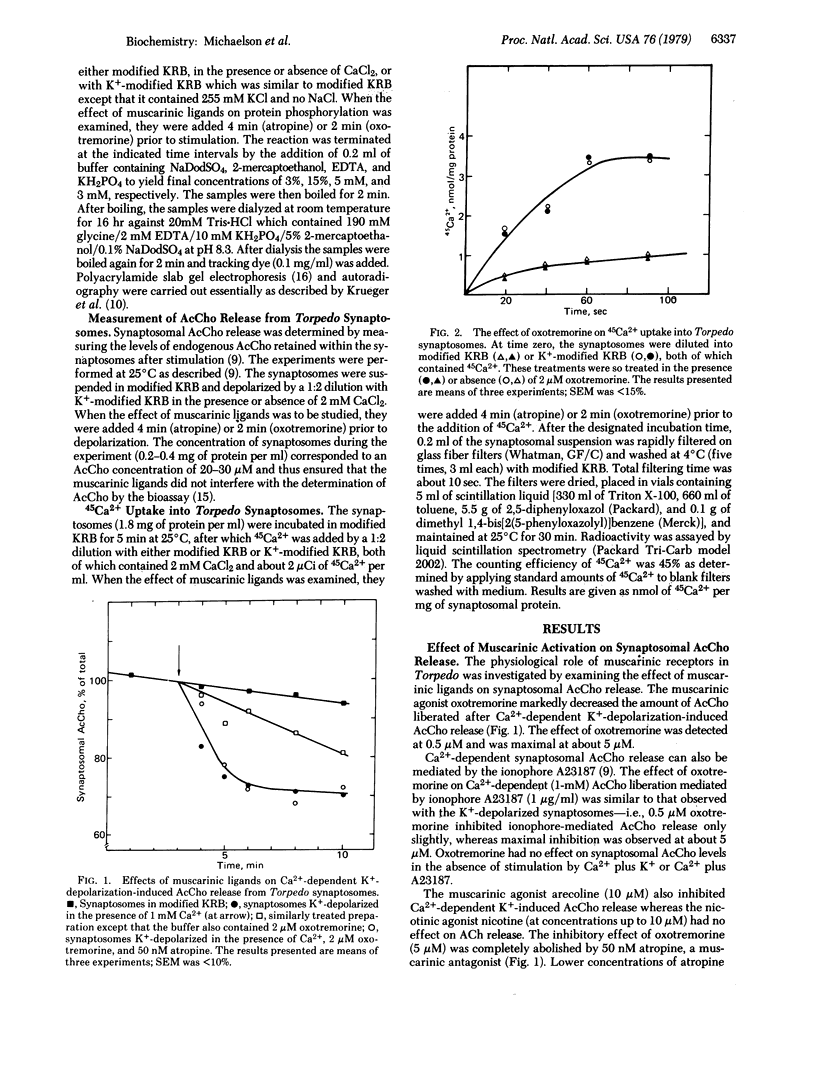
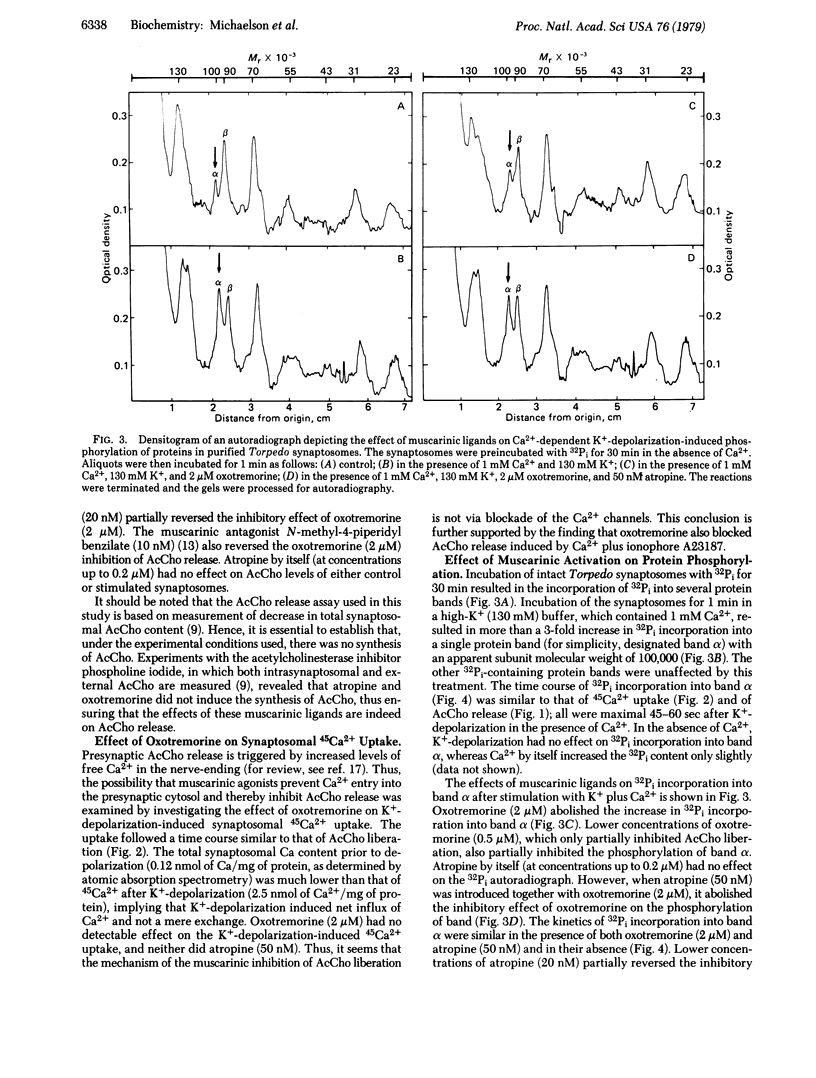
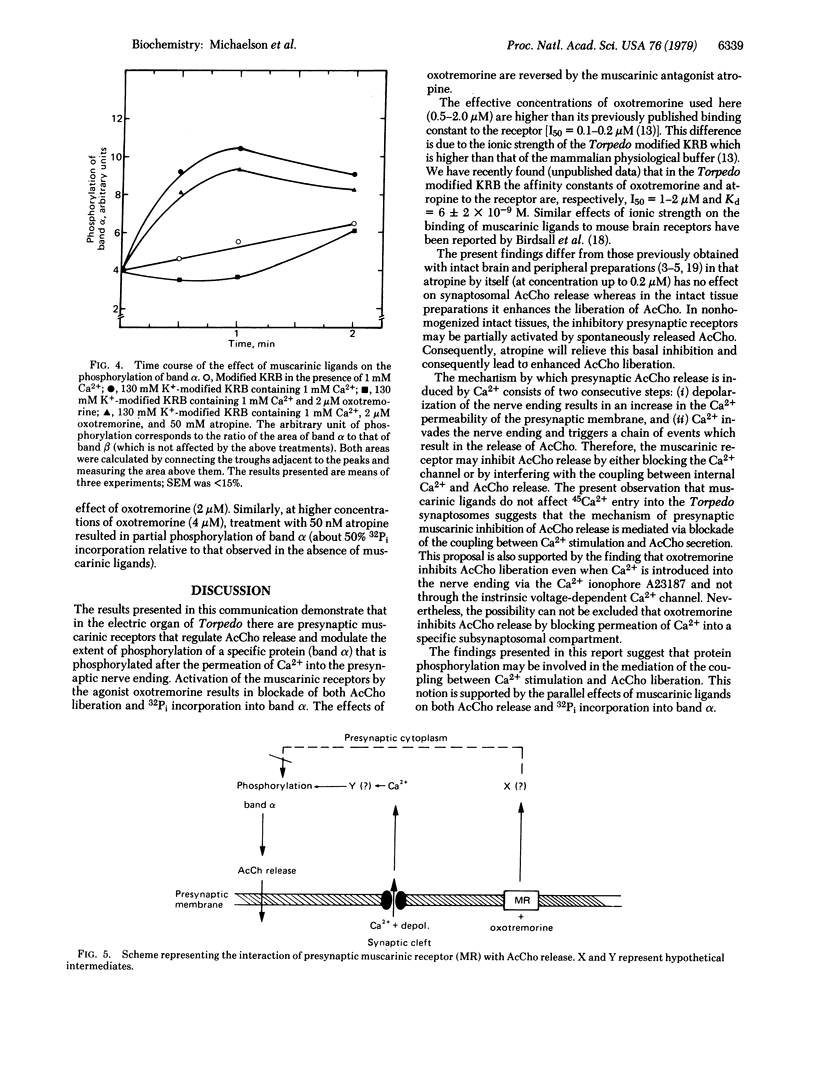
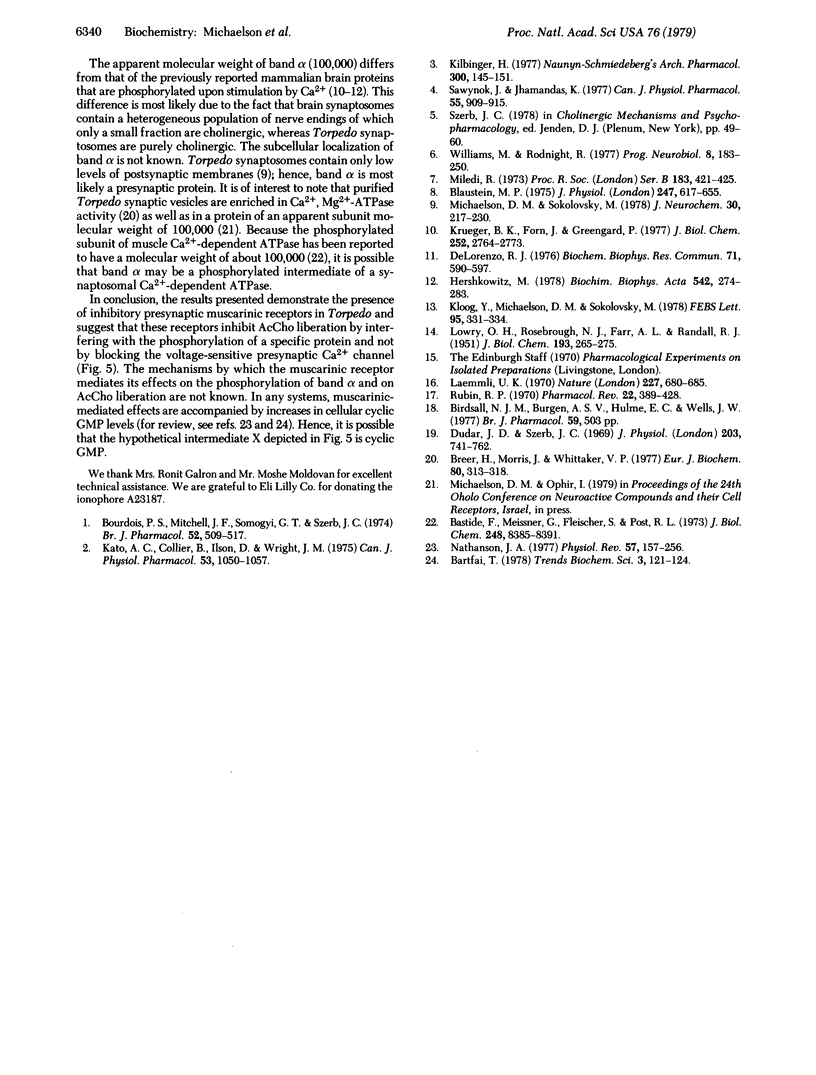
Selected References
These references are in PubMed. This may not be the complete list of references from this article.
- Bastide F., Meissner G., Fleischer S., Post R. L. Similarity of the active site of phosphorylation of the adenosine triphosphatase from transport of sodium and potassium ions in kidney to that for transport of calcium ions in the sarcoplasmic reticulum of muscle. J Biol Chem. 1973 Dec 25;248(24):8385–8391. [PubMed] [Google Scholar]
- Blaustein M. P. Effects of potassium, veratridine, and scorpion venom on calcium accumulation and transmitter release by nerve terminals in vitro. J Physiol. 1975 Jun;247(3):617–655. doi: 10.1113/jphysiol.1975.sp010950. [DOI] [PMC free article] [PubMed] [Google Scholar]
- Bourdois P. S., Mitchell J. F., Somogyi G. T., Szerb J. C. The output per stimulus of acetylcholine from cerebral cortical slices in the presence or absence of cholinesterase inhibition. Br J Pharmacol. 1974 Dec;52(4):509–517. doi: 10.1111/j.1476-5381.1974.tb09718.x. [DOI] [PMC free article] [PubMed] [Google Scholar]
- Breer H., Morris S. J., Whittaker V. P. Adenosine triphosphatase activity associated with purified cholinergic synaptic vesicles of Torpedo marmorata. Eur J Biochem. 1977 Oct 17;80(1):313–318. doi: 10.1111/j.1432-1033.1977.tb11884.x. [DOI] [PubMed] [Google Scholar]
- DeLorenzo R. J. Calcium-dependent phosphorylation of specific synaptosomal fraction proteins: possible role of phosphoproteins in mediating neurotransmitter release. Biochem Biophys Res Commun. 1976 Jul 26;71(2):590–597. doi: 10.1016/0006-291x(76)90828-7. [DOI] [PubMed] [Google Scholar]
- Dudar J. D., Szerb J. C. The effect of topically applied atropine on resting and evoked cortical acetylcholine release. J Physiol. 1969 Aug;203(3):741–762. doi: 10.1113/jphysiol.1969.sp008890. [DOI] [PMC free article] [PubMed] [Google Scholar]
- Hershkowitz M. Influence of calcium on phosphorylation of a synaptosomal protein. Biochim Biophys Acta. 1978 Aug 17;542(2):274–283. doi: 10.1016/0304-4165(78)90023-5. [DOI] [PubMed] [Google Scholar]
- Kato A. C., Collier B., Ilson D., Wright J. M. The effect of atropine upon acetylcholine release from cat superior cervical ganglia and rat cortical slices: measurement by a radio-enzymic method. Can J Physiol Pharmacol. 1975 Dec;53(6):1050–1057. doi: 10.1139/y75-146. [DOI] [PubMed] [Google Scholar]
- Kilbinger H. Modulation by oxotremorine and atropine of acetylcholine release evoked by electrical stimulation of the myenteric plexus of the guinea-pig ileum. Naunyn Schmiedebergs Arch Pharmacol. 1977 Nov;300(2):145–151. doi: 10.1007/BF00505045. [DOI] [PubMed] [Google Scholar]
- Kloog Y., Michaelson D. M., Sokolovsky M. Identification of muscarinic receptors in the Torpedo electric organ. Evidence for their presynaptic localization. FEBS Lett. 1978 Nov 15;95(2):331–334. doi: 10.1016/0014-5793(78)81023-0. [DOI] [PubMed] [Google Scholar]
- Krueger B. K., Forn J., Greengard P. Depolarization-induced phosphorylation of specific proteins, mediated by calcium ion influx, in rat brain synaptosomes. J Biol Chem. 1977 Apr 25;252(8):2764–2773. [PubMed] [Google Scholar]
- LOWRY O. H., ROSEBROUGH N. J., FARR A. L., RANDALL R. J. Protein measurement with the Folin phenol reagent. J Biol Chem. 1951 Nov;193(1):265–275. [PubMed] [Google Scholar]
- Laemmli U. K. Cleavage of structural proteins during the assembly of the head of bacteriophage T4. Nature. 1970 Aug 15;227(5259):680–685. doi: 10.1038/227680a0. [DOI] [PubMed] [Google Scholar]
- Michaelson D. M., Sokolovsky M. Induced acetylcholine release from active purely cholinergic Torpedo synaptosomes. J Neurochem. 1978 Jan;30(1):217–230. doi: 10.1111/j.1471-4159.1978.tb07055.x. [DOI] [PubMed] [Google Scholar]
- Miledi R. Transmitter release induced by injection of calcium ions into nerve terminals. Proc R Soc Lond B Biol Sci. 1973 Jul 3;183(1073):421–425. doi: 10.1098/rspb.1973.0026. [DOI] [PubMed] [Google Scholar]
- Nathanson J. A. Cyclic nucleotides and nervous system function. Physiol Rev. 1977 Apr;57(2):157–256. doi: 10.1152/physrev.1977.57.2.157. [DOI] [PubMed] [Google Scholar]
- Rubin R. P. The role of calcium in the release of neurotransmitter substances and hormones. Pharmacol Rev. 1970 Sep;22(3):389–428. [PubMed] [Google Scholar]
- Sawynok J., Jhamandas K. Muscarinic feedback inhibition of acetylcholine release from the myenteric plexus in the quinea pig ileum and its status after chronic exposure to morphine. Can J Physiol Pharmacol. 1977 Aug;55(4):909–916. doi: 10.1139/y77-121. [DOI] [PubMed] [Google Scholar]


